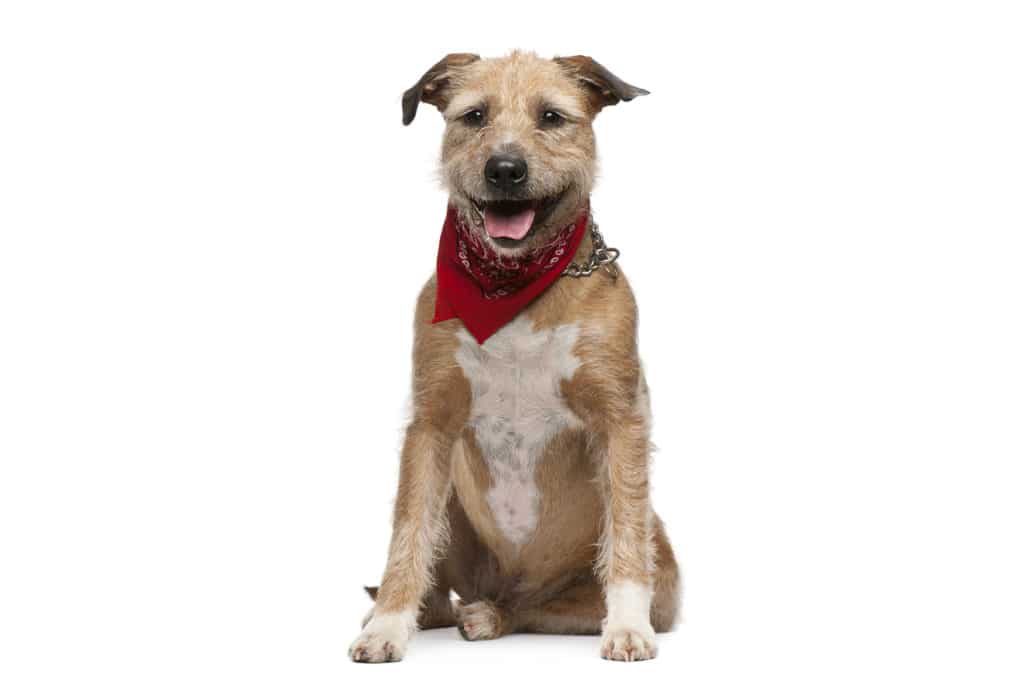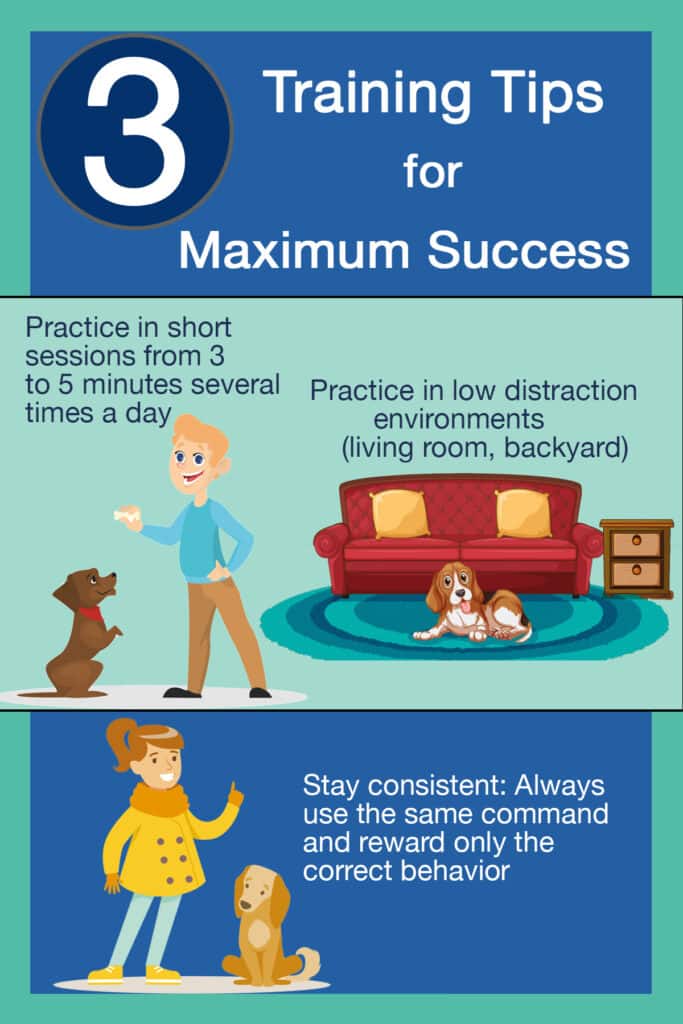How to Teach Your Dog to Sit (4-Step Guide)
- Anja Boecker
- Updated: 2023-09-12
Are you wondering why your dog needs to sit on command? For your dog, sit, down, and stay are like 1×1. 'My dog is well-behaved', you probably think, 'he doesn't need training.' Learning commands isn't about stubborn obedience, it's about communication and trust.

What Is ‘Sit’ in Dogs?
The command 'Sit' is a basic command in dog training that tells the dog to sit. The dog should sit with its rear end on the ground and its front legs straight.
It is one of the simplest and most important basic commands that the dog learns to calm down, focus on the human and also contributes to road safety.
'Sit' can be used as a stand-alone exercise or with other commands to help maintain an orderly and safe environment for your dog and its surroundings.
Why Is Teaching “Sit” So Important?
Have you ever noticed how your dog looks at you when he is unsure? Your pet relies on you. There are situations that make him feel insecure.
Your dog may get nervous when meeting other dogs or when strangers knock on the door. He wonders how to react to the scary situation. Should he attack and defend you?
When you command him to sit, he knows that you are in control. So, he can relax and let you take the lead.
Training your dog has a second positive effect. Your dog needs to be challenged not only physically, but also mentally. Training allows him to show off his intelligence and prevent boredom.
Use the right amount. Train in several short sessions rather than one long session. Give your furry friend long enough breaks to process what he has learned and to rest.
The length of training sessions will vary depending on your dog's breed, age, temperament, and health. In general, it is recommended that dogs be exercised two to three times a day in short sessions of 10 to 15 minutes.
How Do I Teach My Dog to “Sit”?
'Sit' is a simple command to start training your dog. 'Down' and 'Stay' are the next steps. But we are not there yet. Let's work together to teach your dog to sit.

4-Step-Guide
1) Reward Your Dog With Treats
Training should be fun. And what's more fun than a treat from you? If you want your dog to enjoy training, give him a taste of it. Do you know his favorite treat? Not yet? Then find out quickly! The best incentive gets the best result.
2) Train in a Peaceful Environment
Provide a distraction-free environment. This is especially important when you first start training. Your dog may not have any "sit meat" and is easily distracted. Keep him focused on you and the training. Over time, you can increase the difficulty by training in more stimulating environments.
3) Take Advantage of Your Dog's Movements
Hold the treat in front of your dog's snout. Then lift it slightly and slowly bring it back over his head. Your pet will follow the treat with eyes and head movements. Eventually, this won't work. At some point, he will have to change his posture to keep his eye on the treat. As he does so, he slowly lowers his rear end. He is on the right track! Reward him with the treat. Repeat this exercise until he sits down on his own. Important: Resist the temptation to help! Do not push his butt down. Your dog can only successfully learn a new behavior if he does it on his own and is rewarded for it.
4) Introduce the Sit Command
After a few laps, introduce the command 'sit' (or another sound signal of your choice). This will help your dog associate the word with the movement. We also recommend using a hand signal to sit, such as raising your index finger. Many dogs become deaf or hard of hearing as they age. To make sure your pet understands what you want him to do as he gets older, it's a good idea to practice an appropriate hand signal. Remember to end 'sit' with another command (e.g., 'okay').
Too theoretical for you? If you prefer a visual approach, our app offers step-by-step video instructions to help you teach your dog to sit. Learn more about our app here.
‘Sit’ for Advanced Players
Increase the distance:
Increase the difficulty by increasing the distance between you and your dog. Start training in a quiet room and slowly work your way up to longer distances and more distracting environments.
Delay the reward:
Extend the time before you give your dog a reward. Give the command "Sit" and wait a few seconds before giving him the reward. This will teach your dog to wait patiently and keep the command until he gets the reward.
Add distractions:
Practice the sit command in different environments and with different distractions to improve your dog's reliability. Start with less distracting environments and slowly increase the difficulty by adding more distractions.
Unpredictable rewards:
Switch to infrequent rewards to reinforce the sit command. Don't reward your dog every time he sits, but only occasionally. This will help him perform the command more reliably because he won't know when the next reward is coming.
Remember that every dog is different and needs different training methods. Adapt your training to your dog's needs and abilities to achieve the greatest success.
Guides and Tips
Time Your Rewards
Reward small progress with treats. When your dog sits properly for the first time, give him a special reward. For example, you can give him a treat and a long petting session. You can also use words to tell him that he just did something really great! Make sure you always reward the desired behavior immediately. This is the only way your dog can make the mental connection between the two. Do not reward your dog after he has already stood up. If you reward him, he will associate standing up with the treat, not sitting down.
Do Not Overload Your Dog
Always be careful not to overtax your dog! Train several times a day and in short, concise sessions (5-10 minutes) so that your dog can optimally process and internalize what he has just learned. If your dog is unfocused or distracted, you have practiced too much. If this happens, take a longer break. Then let him play or do whatever he wants. Always practice step-by-step at your dog's pace. Always practice first in a low-distraction environment where your dog is not exposed to stimuli and is comfortable.
Be Patient and Positive
Not every dog learns at the same pace. Be patient and continue to encourage your dog with praise and rewards. Avoid punishment or reprimands, which can lead to a loss of confidence and training problems. Punishing or yelling at your dog when he doesn't obey a command can cause him to develop fear or insecurity. Use positive reinforcement and patience instead.
No Pressure
Avoid putting physical pressure on your dog, such as forcing him to sit. This can cause resistance, make training more difficult, and decrease your dog's confidence. Instead, use positive reinforcement and guide your dog into the desired position with treats or hand signals.
Leave Training Positive
Always leave training in a positive mood. If something doesn't work, don't just stop the exercise, but give a command that your dog is sure to do and praise him for it.
Positive Reinforcement
Praise and reward your dog when he responds to the audio cue and performs the desired behavior. Use quality treats or toys to get your dog's attention.
Short and Clear Words
Use simple and clear words for each command, such as 'sit', 'down', or 'here'. Avoid long or similar-sounding words, as they are harder for your dog to distinguish.
Consistency
Be consistent with each command. Always use the same word and do not switch between different phrases or commands.
Clear Pronunciation
Say the commands clearly so your dog understands. Make sure you always use the same intonation and volume.
Be Consistent
After the first day of training, it's: Keep at it! Your dog has just learned to sit. He'll forget the command within a few days if you don't reinforce it. That's why you should repeat new commands every day, especially in the beginning.
Remember:

Teaching Your Puppy to Sit
There are some differences between puppies and adult dogs when it comes to teaching the 'sit' command:
- Patience: Puppies require more patience because they are young and inexperienced. Adult dogs may have already learned some basics and can learn more quickly.
- Attention span: Puppies have shorter attention spans than adult dogs. Therefore, training sessions should be shorter and include more breaks.
- Reward: Both puppies and adult dogs learn better when they are rewarded. You can use treats, praise, or petting. For puppies, choose soft and small treats that are easy to chew and swallow.
- Consistency: Consistency is important for both. The 'sit' command should always be given in the same way and rewarded when successful. With puppies, it is especially important to establish a good routine early on.
- Socialization: Puppies need more time to get used to different environments, people and animals. Training in a variety of situations will help them gain confidence. For adult dogs that are already well socialized, training in different environments may be quicker.
- Reinforcement: With both dogs, it is important to repeat the training regularly to reinforce what has been learned. With puppies, you can incorporate training into everyday life to help them learn new commands quickly.
When Should I Start Teaching My Dog to Sit?
You can and should train puppies while paying attention to their socialization. Both are important to the development of a healthy, happy, and well-behaved dog. The first few months of a puppy's life are crucial for learning basic commands and social behavior.
Puppies can be trained at 7 to 8 weeks of age. You can teach him basic commands such as sit, down, and stay. Train puppies in short, playful sessions of 5 to 10 minutes to avoid overwhelming them.
At the same time, puppy socialization is especially important. During the first 3 to 4 months, puppies should be exposed to different people, animals, environments, and sounds. Good socialization helps them feel safe and relaxed in different situations.
You can combine socialization and training by taking your puppy with you when you visit friends or relatives and having him interact with new people and animals. You can also practice commands in different environments to reinforce them in different situations.
Overall, it's important to nurture and socialize puppies from the start, so they grow up to be happy dogs.
Frequently Asked Questions
Yes, you can, but 'sit' is a good first command because it is relatively easy to learn and gives your dog a quick sense of accomplishment. You want to start with a simple command so that your dog will enjoy training with you in the future. 'Sit' also provides a good foundation for learning Down and Stay.
Yes, even a well-behaved dog should be trained. By training, you can ensure that your dog's mental and physical abilities are improved and that your dog is properly exercised. In addition, training provides an ideal setting to strengthen your relationship and trust in each other.
Yes and no. Some breeds are known for their high energy or independence and therefore require more training and attention than others. Also, just like people, dogs have different personalities and learn at different rates. At the same time, basic commands are the foundation of a good relationship and should be mastered by every dog.
The amount of time it takes for a dog to reliably learn the 'sit' command depends on several factors, including the dog's breed and age, as well as the owner's previous experience and consistency. In general, however, your dog should show progress within a few training sessions. The important thing is to be patient and keep training regular and consistent.
If your dog tends to walk backwards instead of sitting, try practicing in front of a wall or other obstacle. This will discourage your dog from walking backwards and encourage him to follow the treat into a sitting position.
If your dog tries to jump up to get the treat, hold the treat a little lower and don't pull it away. Remember to reward your dog with the treat as soon as he sits down, even if it's just for a moment.
Treats are effective, but you can also pet, praise, play with, or give your dog a toy. It is important to find out what motivates your dog and use a variety of rewards to keep training interesting.
Yes, older dogs can learn new commands, although it may take a little longer. Patience and consistency are important, as is tailoring the training to your older dog's needs and abilities.
Conclusion
The command 'sit' is often the introduction to dog training and is one of the 1×1's for your dog. 'Sit' is easy to learn and provides a quick sense of accomplishment. This motivates both of you to continue training.
Learning new skills is important for your dog's mental development and social behavior. Your dog will learn that you can lead him and that he can rely on you. This gives him security and contributes to a more balanced mind.
Share Now:

My name is Anja Boecker, and I am a certified dog trainer and behavior consultant. With these articles, I want to help you to understand your dog better and to build an inseparable bond.

